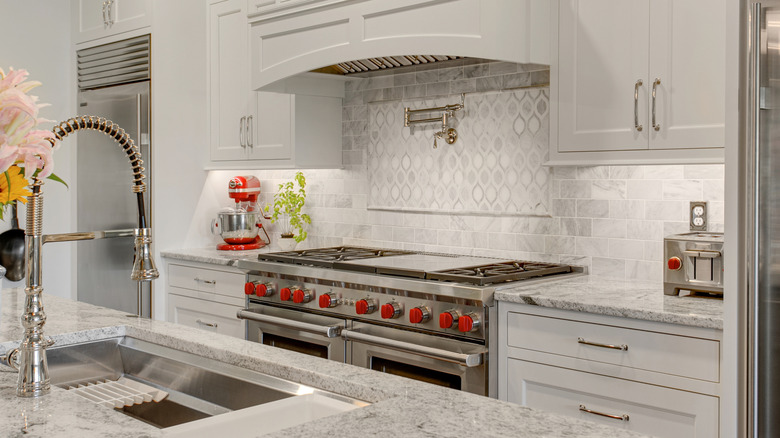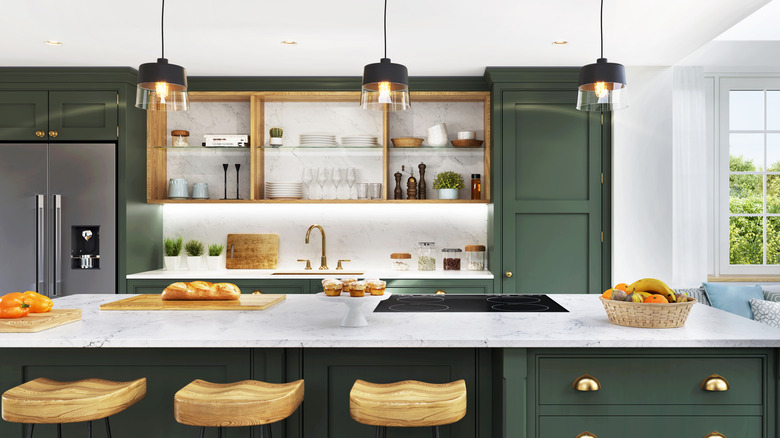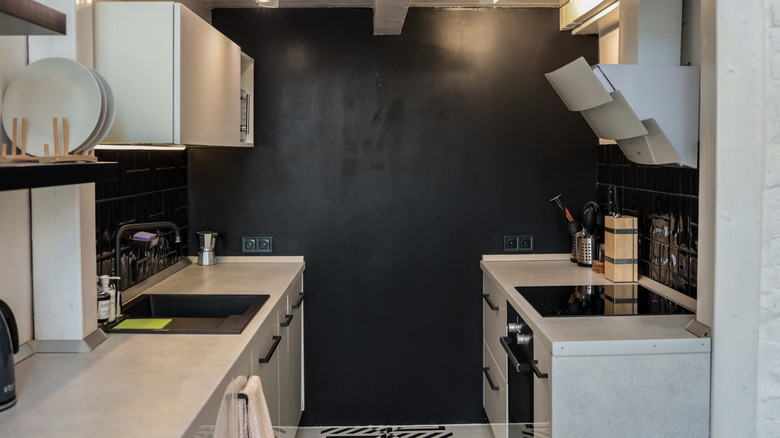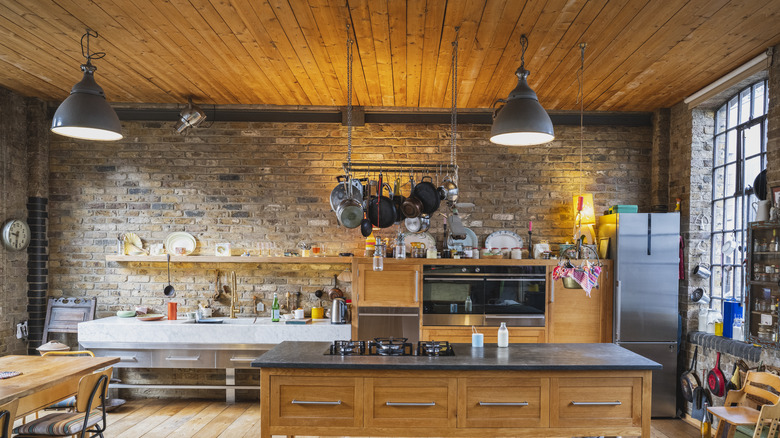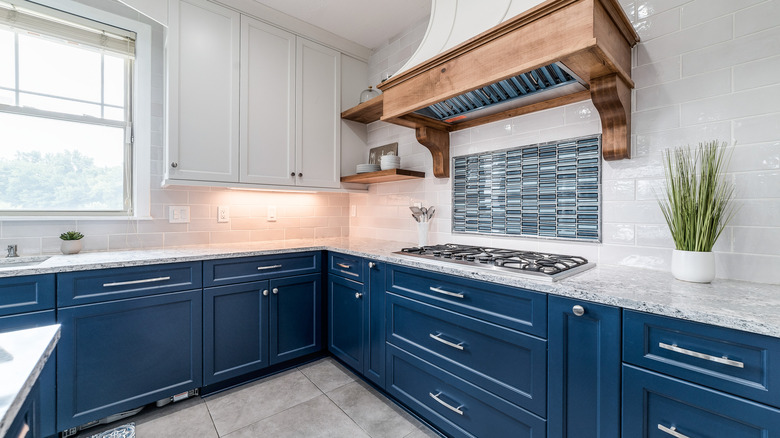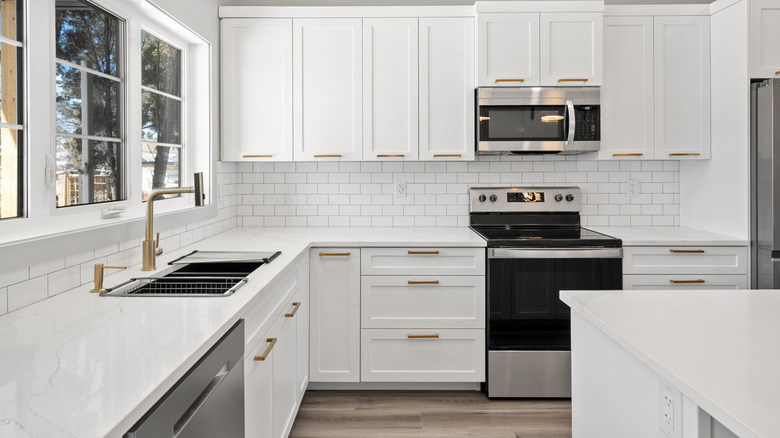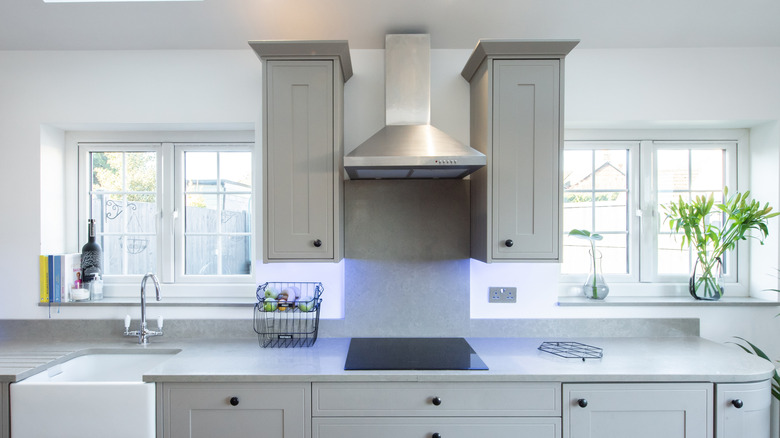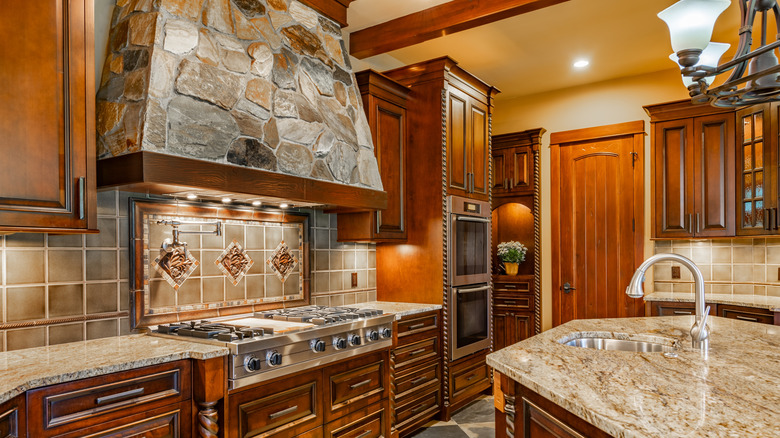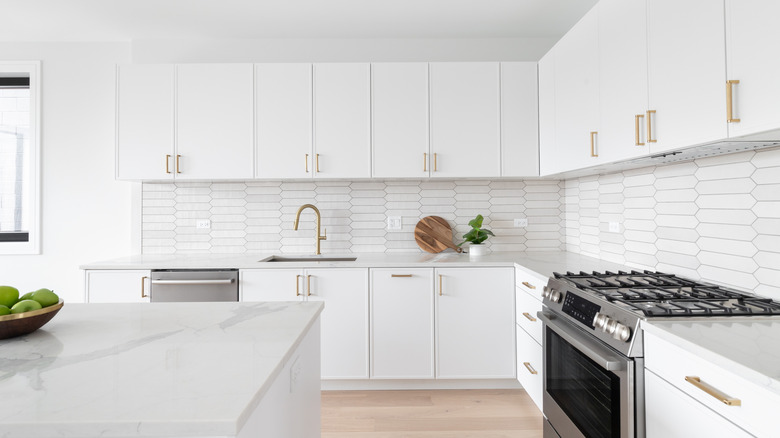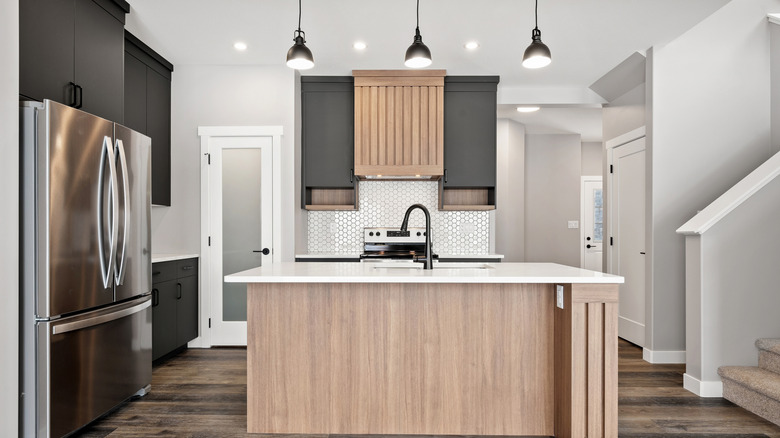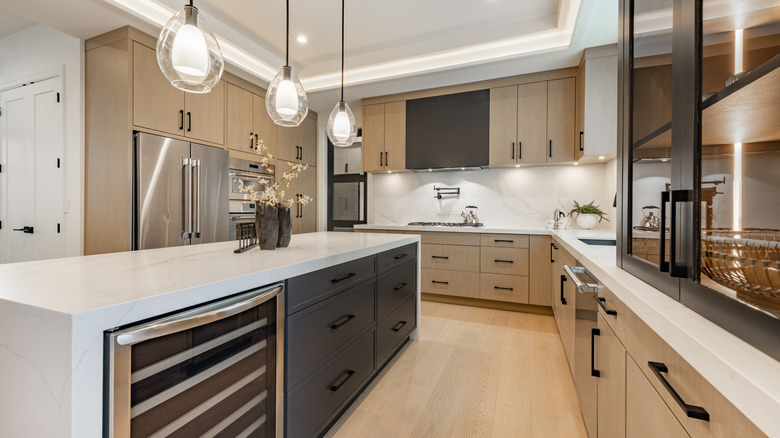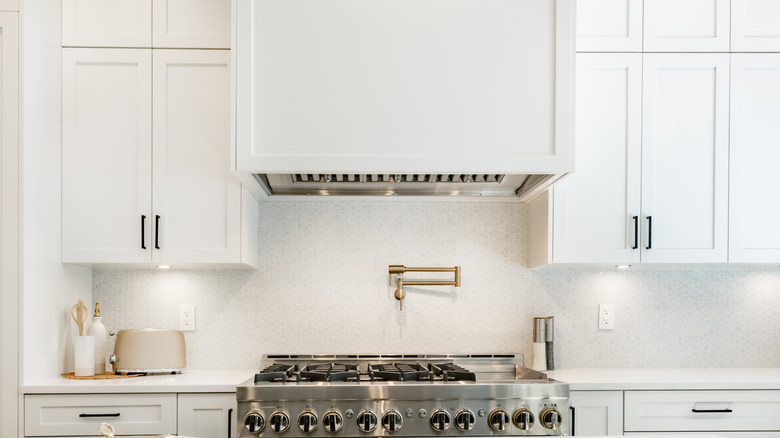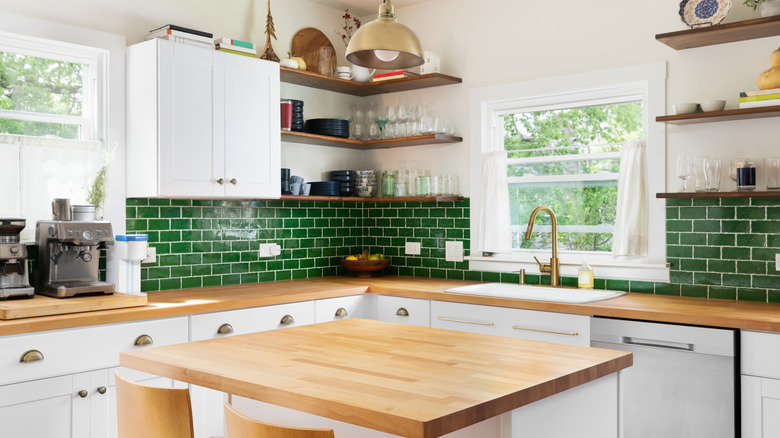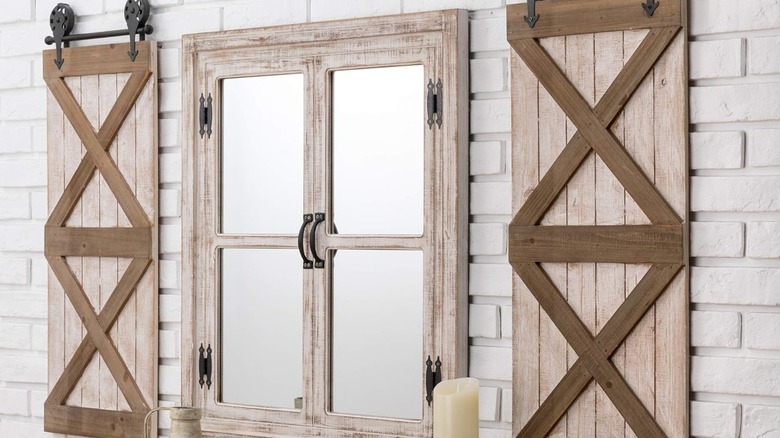13 Outdated Kitchen Trends You Can Leave In The Past
We may receive a commission on purchases made from links.
The Merriam Webster dictionary defines the word trend as "a current style or preference." And kitchen trends are just that: style preferences that are popular at a given time. As times change, trends also shift. This means that your once current and "trendy" kitchen might not still jive with today's design preferences. Understanding what's in (and what's out) can help you as you make plans for your kitchen.
Keeping up with the ever-changing world or design and decor isn't always easy, so that's why we reached out to several experts who do live and breathe kitchen design. We asked for their insights on which once-trendy kitchen design elements have had their day — and what you might want to consider instead when updating your space. Ahead, you'll find the insight these design experts shared when speaking exclusively with House Digest.
Over-styled open shelving everywhere
You probably heard that open shelving has gained a lot of recent popularity in kitchen design. One of the appeals of this trend was the ability to showcase beautiful dinnerware, your favorite vases, and other decor elements. However, there are some downsides to this trend, which is part of the reason why our experts advise against having too many open shelves in a kitchen. "A few open shelves can add charm and personality, but covering every wall in them can start to feel more chaotic than curated," Rebecca Merritt, Owner and Principal Interior Designer at Merritt Design Co., shares during an exclusive interview with House Digest. With too many open shelves, you might feel like you're constantly trying to keep things clean. When your everyday dishes, baking supplies, and cookware are on the shelves, this can be even more challenging and overwhelming.
Rachel Blindauer, an award-winning interior and product designer, highlights another reason why kitchens with expansive open shelving have had their moment. "I see homeowners more stressed about dust than design," she reveals. With all of these cons, many real estate agents caution against too much open shelving in a kitchen — it can turn some potential buyers away. While our experts warn against going overboard with open shelving in your kitchen, they both acknowledge that it can still have a place in the overall design if used correctly. "I often recommend partial open shelving or shallow niche displays instead, with hidden storage below to keep daily life tidy," says Blindauer.
Matte black everything
When your goal is to create a warm and welcoming kitchen, there's a once-trendy design feature that can stand in your way, according to Blindauer. She identifies relying too heavily on matte black finishes as something that no longer matches modern design goals: "At first, it felt fresh. Now, it's everywhere. Hardware, faucets, cabinet pulls — all matte black. But when an entire kitchen leans into it, the effect starts to feel flat." Blindauer shares that she's had clients remark that their kitchens feels overly cold after opting for this outdated hardware trend.
If you like the look of matte black, don't worry — Blindauer isn't saying that it doesn't deserve any space in a kitchen. Instead, she recommends being very intentional about how you use it and avoiding being over-reliant on this one finish. "I suggest contrast — mix black with aged brass or unlacquered bronze. Or bring in matte black as a punctuation, not the whole sentence," she shares. For example, if you want to stick with matte black cabinet pulls, consider pairing them with an oil rubbed bronze faucet, such as this Delta Capertee Oil Rubbed Bronze Kitchen Faucet. If you already have a lot of matte black in your kitchen, taking the opposite approach and keeping the faucet and swapping out the hardware may be another approach. You might decide to replace your cabinet pulls with these Ravinte Champagne Bronze Square Cabinet Handles.
Industrial overkill
Industrial kitchens were all the rave not that long ago. However, this trend is also sailing off into the sunset, according to Blindauer. She shares, "Exposed bulbs, metal bar stools, concrete counters, blackened steel — there's a version of industrial that feels like you're cooking in a pop-up restaurant." Too many industrial elements can just make your kitchen feel overly cold — or even completely sterile.
If you've been wondering why your kitchen looks so cold and how to make it feel more cozy, you're not alone. Blindauer explains that many of her recent clients have also expressed the desire to create a softer and warmer space. She says, "I like layering in more texture — think limewashed plaster, glazed tile, or wood with patina. Industrial can still work, but it needs a counterbalance." You could also consider introducing some warmth by adding a runner, such as the Hy Hao Yun Lai Runner Rug, or some potted plants.
Two-tone shaker cabinets in stark contrast
It wasn't too long ago that design magazines featured page after page showcasing two-toned kitchen cabinets with a deep contrast. However, according to Blindauer, while this once delivered a statement, today it is becoming too commonplace and "formulaic." Beyond the way the trend has been overused, Blindauer also notes that "the contrast often interrupts the flow of smaller kitchens."
You can still add some visual intrigue and contrast in your kitchen without leaning so heavily on such stark differences. "A softer approach I've used recently is tone-on-tone: warm cream uppers and taupe or mushroom base cabinets," says Blindauer. She continues, "It's still layered, just more nuanced." Opting for a softer combination will still make your space visually appealing. The two colors will catch the eye of anyone who steps into the space. You could even consider adding a few deeper-colored accents — such as this Tanvecle Blue Ceramic Vase — to add a little bit more contrast, without going too overboard.
Stainless steel appliances don't have to be the default
During an exclusive interview with House Digest, Gretchen Rivera, the principal designer at Casa Casual Interiors, offera her thoughts on kitchen appliance trends. She says, "For years, stainless steel was seen as the only 'serious' choice for kitchen appliances, but now it just feels flat." Everyone may not be in agreement about whether stainless steel appliances are fully out of style. However, there certainly are some benefits associated with exploring other options. The sleek and shiny material does not hide scratches or fingerprints very well. So, it may make your kitchen look dingy or dirty.
If Rivera doesn't recommend automatically defaulting to stainless steel appliances when redesigning or renovating your kitchen, what does she recommend? "Homeowners today are embracing appliances in various colors that add personality to the space and panel-ready appliances that integrate with cabinets seamlessly. Your fridge doesn't have to scream 'I'm an appliance!' anymore," she says. Consider incorporating some colorful appliances into your decor by letting them enhance the overall look and feel of your space. With the many colorful appliances on the market, this is easily doable. You can also find appliances that can deliver that retro feel, with colors such as mint green or red
Stainless steel range hoods are a missed design opportunity that feels basic and builder-grade
Every kitchen should have a range hood — they provide adequate ventilation. This is essential for minimizing cooking odors, removing pollutants, and ensuring that too much moisture doesn't accumulate. However, while it is important to have a range hood in the kitchen, Rivera cautions against choosing just any ol' stainless steel one you can find at your local big box home improvement store. She says, "A boxy stainless hood doesn't do much for the room." By choosing a basic stainless hood, you're missing the opportunity to introduce more character and customization into your kitchen.
Rivera recommends opting for something with more excitement and visual appeal. She says, "Today, we're seeing custom range hoods made of drywall and plaster, wood, tile, stone, even copper. They turn a functional necessity into built-in art for your kitchen wall." Each of these materials will deliver a different impact to a kitchen. For example, a copper hood could be the perfect fit for a rustic kitchen, looking even more the part as its patina develops over the years. On the other hand, a tiled range hood can add warmth and personality. You'll be able to choose from various colors, and even patterns, when selecting the tile to match your personal style.
Overly ornate range hoods are also out
While many designers recommend opting for a custom range hood to add some charm and character to your space, Merritt cautions against going all out with the design. She says, "A range hood should make a statement, but not scream for attention. The super decorative, oversized hoods we used to see everywhere are starting to feel out of step." Avoid mixing too many different colors or patterns, or trying to add ornate details that will steal the show.
Instead, Merritt recommends toning down the design. She shares, "I like to simplify the shape and let the materials shine, whether it's a smooth plaster finish, warm wood, or a subtle stone detail. It still feels special, just in a way that's more natural and timeless." So, while a wood range hood could certainly accomplish this goal, one with intricate carving is something you might want to reconsider adding to the design of your kitchen. It's all about striking the balance between too sterile and too elaborate.
White-on-white kitchens don't feel fresh anymore
All white kitchens can make the space feel brighter by reflecting more natural light. With all this natural light bouncing around, it also creates the illusion of extra space to make your kitchen seem larger than it really is. This is why all white kitchens have been so popular over recent years. However, some design experts, including Rivera, don't consider them the trendiest option anymore. "Traditional white-on-white kitchens once looked crisp and clean, but now they're starting to feel ... bland," she says.
Instead, Rivera explains, "Homeowners are choosing nature-inspired hues, like earthy greens, muted blues, soft terracotta tones, or a combination of wood and colors. Or they're blending wood with painted finishes for a more grounded, layered feel." While an all white kitchen can lack depth, Rivera highlights how these earthier tones and blended finishes add dimension to the space. Moreover, when you opt for a white kitchen, you run the risk of making the room feel cold and sterile. "Swapping bright whites for soft, creamy tones and bringing in natural textures like white oak or handmade tile creates a space that feels layered and inviting, not stark," explains Merritt.
A single, enormous refrigerator is no longer the pinnacle of classy kitchen design
If you prepare meals for a large family or do a lot of entertaining, then having sufficient fridge and freezer space is something to consider as you're designing a new kitchen. Not too long ago, you were likely to find professional-designed kitchens that featured commercial-sized fridges. However, while you want to make sure that you have ample fridge/freezer space, Rivera notes that having an oversized refrigerator is not as trendy as it used to be. She says, "One big fridge can dominate a kitchen visually and energetically." If you consider the portion of your space you'll need dedicated to such a large appliance, it's easy to see how it can dwarf the cabinets around it and steal the show.
Don't worry, though, Rivera isn't saying that you'll have to cram all of your food into a standard size refrigerator/freezer combination if that doesn't match your needs. Instead, she explains, "More homeowners are installing smaller fridges under counters for drinks, snacks, and even separate freezers hidden in pantries." Rivera notes that making this swap will not only allow the other design elements in the kitchen to shine, but says that it may also help save you money. Large, commercial refrigerators are not very energy-efficient, so opting for a few smaller, Energy Star-certified models can also be a wise decision for your bank account.
Perfectly-matched hardware is overdone
One of the finishing touches you'll be adding to a new kitchen is the cabinet hardware. You may be tempted to look for knobs and pulls of the same style and finish. There are a few reasons why designers used to opt for perfectly matched hardware. One of the primary reasons was to make the different elements of the space look like they belong together by creating a sense of cohesiveness. However, according to Rivera, this is a trend that you can also say goodbye to as you rethink your kitchen: "The limitation of using only one metal finish and style of cabinet pulls and knobs has been overdone."
As trends and visions change, professionals are realizing that matchy-matchy hardware is not the only solution for adding cohesiveness to their designs. "Mixing metals with porcelain or a different metal can be an effective way to personalize cabinets, feeling curated, not chaotic," explains Rivera. However, while some mixed metals and different hardware styles can achieve this more personalized and curated look, she notes that you still need to be very purposeful about which pieces you add to the design and where you place them. Balance is essential, she explains. Otherwise, you run the risk of making your kitchen feel haphazard or chaotic. If you're not ready to undertake a full kitchen remodel right now, these cabinet hardware trends can give your kitchen an upgrade on a budget immediately.
Pot fillers can be impractical and less functional than people assumed
Over the past few years, pot fillers have become increasingly popular in a kitchen. These wall-mounted faucets above a range or cooktop make it quick and easy to fill a pot with water. They've been seen as a luxury addition to a kitchen and have been one that several home chefs have wanted to work into their designs, despite the high price tag. According to Jonathan Palley, the CEO of Clever Tiny Homes, you might want to reconsider your desire to add a pot filler if you're looking to keep up with current trends.
During an exclusive interview with House Digest, Palley explains, "The issue here is that they take up valuable space, especially in small kitchens, and they require a lot of extra plumbing for minimal gain. Unless you're regularly boiling large pots of water, don't bother." All that extra plumbing makes these a very costly addition to a kitchen, which is a serious con of having a pot filler. If your stove is not on the same wall as your sink, you won't have the necessary plumbing behind it — and you could easily pay at least $3,000 to have a plumber add the pipes. The filler also won't eliminate the need to carry heavy pots back and forth between the sink and the stove — you'll still need to drain those huge pots of pasta, right? Instead of giving up precious space for an expensive pot filler, consider Palley's advice to skip this addition. Instead, opt for a sleek and modern backsplash behind your range or cooktop.
A butcher block countertop isn't a reigning aesthetic anymore
If you have a butcher block countertop in your kitchen, or are thinking of integrating one into a kitchen renovation project, Rick Berres, owner of Honey-Doers, explains why you might want to reconsider it. "The butcher block ruled 2020 and even before that, but its reign of terror is rapidly coming to an end," he shares when speaking exclusively with House Digest. There are other things you should know before buying a butcher block countertop, which may also convince you that they're not the right choice for your kitchen. Beyond not meshing with current design trends, the wooden material is very prone to scratches and dents. Despite what you may guess based on the name, slicing and chopping directly on these surfaces is not recommended. Additionally, wooden surfaces can harbor bacteria if they're not properly cared for.
As an alternative to butcher blocker countertops, Berres explains, "There are other sleeker, more elegant, and more durable options, like quartzite, which is very very in right now." Quartzite, a natural stone, is very durable and easy to care for. It should be sealed about once per year, but then is easy to clean using just some mild dish soap and water. Moreover, quartzite can add style and dimension to your kitchen with the wide assortment of colors and patterns that are available.
Overly themed farmhouse details feel flat
Farmhouse kitchens have been very popular recently. While Eunice Weckesser, the principal and founder of Crown The Cool Studios, doesn't see that popularity waning, she does note some changing trends in how they're styled and designed. "The overly rustic, shiplap-heavy farmhouse kitchen has lost its edge," she shares with House Digest.
Instead, Weckesser advises using more restraint when designing a farmhouse kitchen. Instead of going overboard with certain elements, she recommends keeping things a bit more subtle: "Swap distressed finishes and overly literal barn accents for tailored millwork, vintage hardware, or reclaimed materials used in a more refined way." For a more budget-friendly alternative, you might consider some antique-look cabinet hardware, such as the Cabdm Rustic Black Cabinet Pulls or the Khtumeware Antique Brass Cabinet Cup Pulls.
